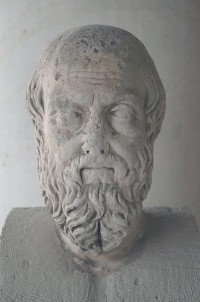Hanno the Navigator (3)
In the first half of the sixth century BCE, the Carthaginian admiral Hanno made a long voyage along the African west coast. His logbook contains a description of a fully active volcano and the first known report about gorillas.

Hanno's report was an inscription in a Carthaginian temple; what we have been discussing up till now was a Greek adaptation of this text. However, there are some ancient texts that help us reconstruct the original. The oldest of these is written by the Greek historian Herodotus of Halicarnassus (ca.480-425 BCE), who states that:
The Carthaginians tell us that they trade with a race of men who live in a part of Libya beyond the Pillars of Heracles. On reaching this country, they unload their goods, arrange them tidily along the beach, and then, returning to their boats, raise a smoke. Seeing the smoke, the natives come down to the beach, place on the ground a certain quantity of gold in exchange for the goods, and go off again to a distance. The Carthaginians then come ashore and take a look at the gold; and if they think it presents a fair price for their wares, they collect it and go away; if, on the other hand, it seems too little, they go back aboard and wait, and the natives come and add to the gold until they are satisfied. There is perfect honesty on both sides; the Carthaginians never touch the gold until it equals in value what they have offered for sale, and the natives never touch the goods until the gold has been taken away.note
It is very likely that this story is based upon Hanno's original report. Two Arab authors, the Sicilian Abu Abdallah Muhammad ibn Muhammad al-Idrisi (1100-1166) and the Syrian Ibn Abdallah ar-Rumi al-Hamawi Yacut (1179-1229), independently state that this method of bartering was still practiced in their own days by gold producers from the Bambouk region.note This suggests that Hanno's trip to the Senegal was a trade mission.
The Greek author Arrian of Nicomedia (second century CE) writes:
The Libyan Hanno left Carthage and sailed beyond the Pillars of Heracles on the Atlantic Ocean, keeping Libya on his left hand. He sailed eastwards for thirty five days. But when he turned to the south, he encountered many problems: lack of water, burning heat and rivers of fire flowing into the sea.note
This brief statement does not seem very spectacular, but it is in fact a very remarkable. The ancient map makers saw Africa as a trapezium or a triangle with the Mediterranean coast as its longest side. Arrian's statement that Hanno sailed to the east and then southwards, can therefore not have been invented and must go back to Hanno's report. (Besides, this proves that the Chariot of the Gods cannot be Mount Kakulima.)
The third text is the Natural history by the Roman encyclopedist Pliny the Elder (first century CE). He is not a credulous writer: he dismisses several stories which grew up around Hanno's journey as fabrications.note This forces us to take the following statement very serious:
When the power of Carthage flourished, Hanno sailed round from Cádiz to the extremity of Arabia, and published a memoir of his voyage, as did Himilco when he was despatched at the same date to explore the outer coasts of Europe.note
We know of an earlier circumnavigation of Africa by Phoenicians in the last years of the seventh century BCE.note There are indications that the Arabs knew the gold mines of Zimbabwe and jealously guarded the trade route along the African east coast. We may speculate that Hanno did not break off his expedition at Corisco Bay, but rounded the Cape of Good Hope and reached Zimbabwe and the Arabian Peninsula.
This is speculation, but there is one point in Hanno's story where he may betray himself. It is the use of the word "gorilla", which renders the kiKongo words ngò dìida ("powerful animal that beats itself violently"): a nice description of the gorilla's characteristic drumming on the chest. In Hanno's days, the speakers of this language probably lived quite close to the lower Zaire;note using one of their words, Hanno admits that he has travelled below the Equator.
Literature
This short text has provoked a remarkable interest among scholars. Its text was first published by Karl Müller (Geographi Graeci Minores, volume I; 1855 Paris; reprint 1965 Hildesheim). A second text edition was edited by Jerker Blomqvist, The date and origin of the Greek version of Hanno's Periplus, 1979 Lund). The topography of Hanno's journey has been discussed by W.F.G. Lacroix in the fourth appendix of his Africa in Antiquity. A linguistic and toponymic analysis of Ptolemy's map of Africa (1998 Saarbrücken). This appendix has been used very intensively in this article.